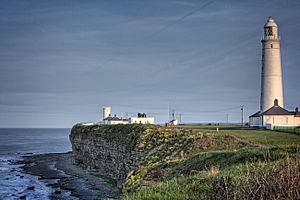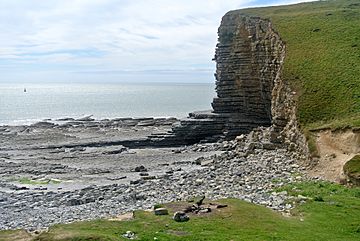Nash Point facts for kids
 |
|
| Low Tower, Keepers cottages, Fog Horn house and Lighthouse at Nash Point | |
| Location | St Donats Vale of Glamorgan Wales United Kingdom |
|---|---|
| Coordinates | 51°24′03″N 3°33′08″W / 51.400863°N 3.552259°W |
| Year first constructed | 1832 |
| Automated | 1998 |
| Construction | stone tower |
| Tower shape | tapered cylindrical tower with balcony and lantern |
| Markings / pattern | white tower and lantern |
| Height | 37 metres (121 ft) |
| Focal height | 56 metres (184 ft) |
| Original lens | 360mm catadioptric |
| Intensity | 134,000 candela |
| Range | 21 nautical miles (39 km; 24 mi) |
| Characteristic | Fl (2) WR 15s. |
| Admiralty number | A5406 |
| NGA number | 5816 |
| ARLHS number | WAL-017 |
Nash Point (which is Trwyn yr As in Welsh) is a special piece of land that sticks out into the sea. It is located on the coast of the Vale of Glamorgan in south Wales. This area is known for its beautiful cliffs and beaches.
Nash Point is a popular spot for people who enjoy walking. Many visitors like to hike along the cliffs all the way to Llantwit Major beach. The field near the lighthouse is a protected area called a Site of Special Scientific Interest. This means it is home to rare plants, like the tuberous thistle, and interesting birds such as choughs.
The cliffs at Nash Point are part of the Glamorgan Heritage Coast. They are made of limestone rocks that have softer layers in between. Because of this, the cliffs can slowly wear away from the sea. You can find many fossils here, including ancient sea creatures like ammonites and gryphaea.
A small stream called Marcross Brook flows through the cliffs. There are also signs of an ancient Iron Age fort, sometimes called Nash Point Camp. Even though much of it has been worn away by the sea, you can still see parts of it. Nearby, you might also find old burial mounds called Round barrows.
Contents
Nash Point Lighthouse: A Guiding Light
The Nash Point Lighthouse is a very old and important building. It was built between 1831 and 1832 and is now a Grade II listed building. This means it is protected because of its historical importance.
The lighthouse actually has two lights: a high light and a low light. They are about 300 meters apart. An earlier light, which helped guide ships, was removed in the 1920s. This was because the sandbank it warned about had moved.
Building the Lighthouse
The lighthouse was designed by James Walker, who was the main engineer for Trinity House. Trinity House is the group that manages lighthouses in England and Wales. The idea to build the lighthouse came after a sad event in March 1831. A ship called The Frolic crashed on the Nash Sands, and over 50 people lost their lives. The ship was traveling from Bristol to Haverfordwest.
The Nash Point Lighthouse first shone its light in 1832. It was updated to use electricity in 1968. In 1998, it became the last lighthouse in Wales to be operated by people. After that, it was automated, meaning machines took over its operation.
Visiting the Lighthouse Today
Today, the lighthouse is open for visitors to explore. It is even used as a place for weddings! Trinity House offers tours for the public to learn more about its history.
The lighthouse also has a fog signal, which used to help ships in foggy weather. Ships don't need it anymore, but it is still sounded on the first Saturday and third Sunday of each month. This is a special treat for visitors. You can even rent out the cottages around the lighthouse for a holiday stay.
Shipwreck at Nash Point
In 1962, an empty oil tanker called BP Driver (which used to be named BP Explorer) was pushed onto the rocks near Nash Point. The five crew members on board were able to get to safety, and everyone survived. Even with the help of the lighthouse, the ship's captain could not bring it safely to shore.
If you visit Nash Point at low tide, you can still see parts of the shipwreck. Its remains are about 200 meters north of the path that leads to the beach, near the lighthouse.



